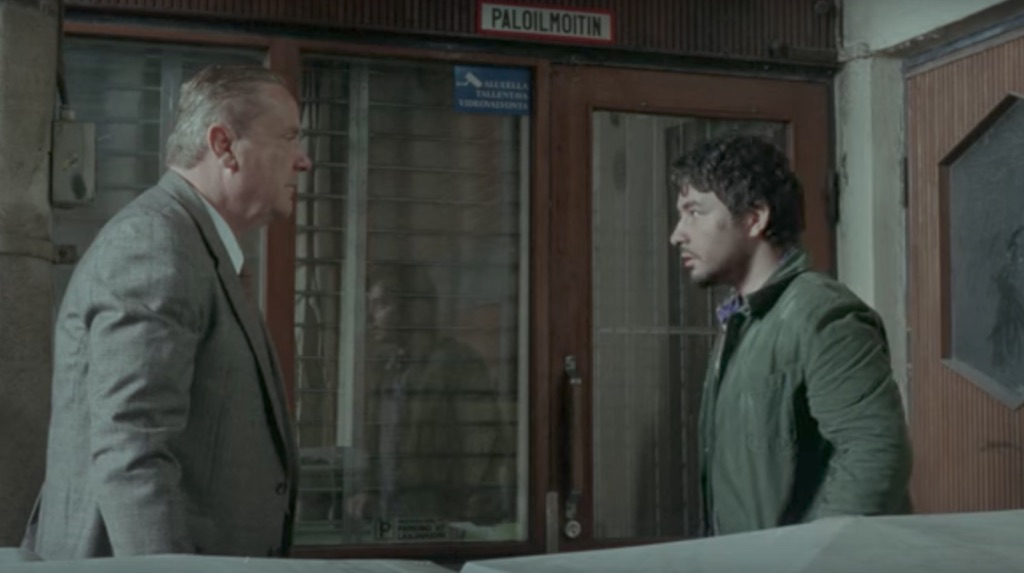‘The Other Side of Hope’: A Dry Look at Refugees in Finland
Aki Kaurismäki delivers a minimalist portrait of an asylum-seeking refugee from Syria. Sherwan Haji (right) and Sakari Kuosmanen in a scene from "The Other Side of Hope." (Curzon Artificial Eye / YouTube)
Sherwan Haji (right) and Sakari Kuosmanen in a scene from "The Other Side of Hope." (Curzon Artificial Eye / YouTube)
Aki Kaurismäki had a mission for his new film, “The Other Side of Hope.”
“With this film, I try my best to shatter the European way of only seeing refugees either as pitiful victims or as arrogant economic immigrants invading our societies to steal our jobs, our wives, our homes, and our cars,” the Finnish director said in a statement. “In European history, the creation and enforcement of stereotypical prejudices carry a sinister echo.”
In 2015, when Finland allowed in 30,000 refugees from several war-torn countries, the anti-immigrant backlash was immediate, with a majority polled saying they would rather live next door to an alcohol rehab clinic than a mosque.
Kaurismäki addressed the issue after winning the Silver Bear for Best Director at the Berlin Film Festival last January. “In Finland, 30,000 Iraqi refugees arrived, and both the young Finnish and the old Finnish took it as a war—‘somebody’s attacking us,’ like Russia 50 or 60 years ago. This attitude was intolerable, in my opinion, and I didn’t like to see that in my compatriots,” he said at a news conference, cheekily adding, “I’m very modest. I don’t want to change the audience. I want to change the world.”
While his new film isn’t likely to do that, the world has changed for lead actor Sherwan Haji, himself a 2010 immigrant from Syria. He plays Khaled, recently arrived from Aleppo, where he came home from work one day to find his house reduced to rubble. Arriving in Finland as a stowaway aboard a cargo ship, he takes his first steps in the new country and is almost hit by a car.
The driver of that car is a man called Wikström (frequent Kaurismäki collaborator Sakari Kuosmanen), who has just left his wife in a wordless scene, the final shot of which shows her pouring a stiff drink at the breakfast table. He is on his way to work, where he quits his job and looks to recruit a stoic co-worker in a new venture. But she too is quitting, with plans to move to Mexico City and “drink sake and dance the hula hula.”
The scene neatly captures Kaurismäki’s sense of humor, which is drained of mirth and moisture, making him the driest joker in cinema. But Khaled’s story is no laughing matter, even though he’s told to keep smiling at his asylum hearing, since they’re more likely to deport “melancholics.” This advice comes from his new friend, Mazdak (Simon Al-Bazoon), a bunkmate in the dormitory for refugees.
The ironic, dry hipsterism of the era (Jim Jarmusch, anyone?) is Kaurismäki’s trademark, dating as far back as his 1989 breakthrough movie, “Leningrad Cowboys Go America.” But whatever drama is kindled in “The Other Side of Hope” seems dampened by the director’s phlegmatic approach. Little is gained by telling Khaled’s story with minimal emotion. It doesn’t make it more powerful, just more demanding.
A similar minimalism is expressed in the movie’s sparse and antiseptic locations and sets, which Kaurismäki reportedly decorated after a falling out with his longtime decorator Markku Pätilä. Lighting by cinematographer Timo Salminen appears more expedient than styled, mainly hitting the subject, with backgrounds falling into shadow. Shooting in the classic manner, Kaurismäki’s camera stays wide, covering the action in mostly masters and two-shots, with minimal movement or use of close-ups.
This aesthetic evokes B-films from the 1940s and ’50s. It could be interpreted as an allegorical device connecting the “The Other Side of Hope” to the past, lending it a timelessness, but it’s the same style Kaurismäki’s been using since 2006’s “Lights in the Dusk.”
Wikström could be mistaken for a character from a 1940s movie. He dresses the part and even drives a car from the period. After quitting his job, he wins a pot of money from a gangster in a high-stakes poker game. The money goes toward purchasing a bar/restaurant called The Golden Pint, staffed by Kaurismäki regulars Janne Hyytiäinen as a semi-qualified cook, and Ilkka Koivula as a doorman who looks like he works at a strip club. Joining them is newcomer Nuppu Koivu as an apathetic waitress.
One day, Wikström finds Khaled sleeping in the alley. The two mix it up, bloodying each other’s noses, but Khaled wins Wikström’s respect as well as a new job at The Golden Pint.
Kaurismäki’s Helsinki is a calm and drab city characterized by boredom and aging rockabilly singers who provide musical interstitials throughout the movie. His Finland is a place where people seem resigned to the fact that joy is for those who live elsewhere. But lurking beneath the ennui is a seething hatred.
In 2015 Finnish white supremacist Mika Ranta founded Soldiers of Odin, with cells spreading to dozens of towns and cities within a year. Kaurismäki addresses the issue by including a like-minded group calling itself Liberation Army of Finland, which plays a prominent role in the movie’s climax.
“The Other Side of Hope” is a story of courage in the face of casual cruelty. And although Kaurismäki might be accused of confusing passion with sentimentality, thereby avoiding it like the plague, the result is a unique movie on an urgent topic told without urgency.
Independent journalism is under threat and overshadowed by heavily funded mainstream media.
You can help level the playing field. Become a member.
Your tax-deductible contribution keeps us digging beneath the headlines to give you thought-provoking, investigative reporting and analysis that unearths what's really happening- without compromise.
Give today to support our courageous, independent journalists.



You need to be a supporter to comment.
There are currently no responses to this article.
Be the first to respond.